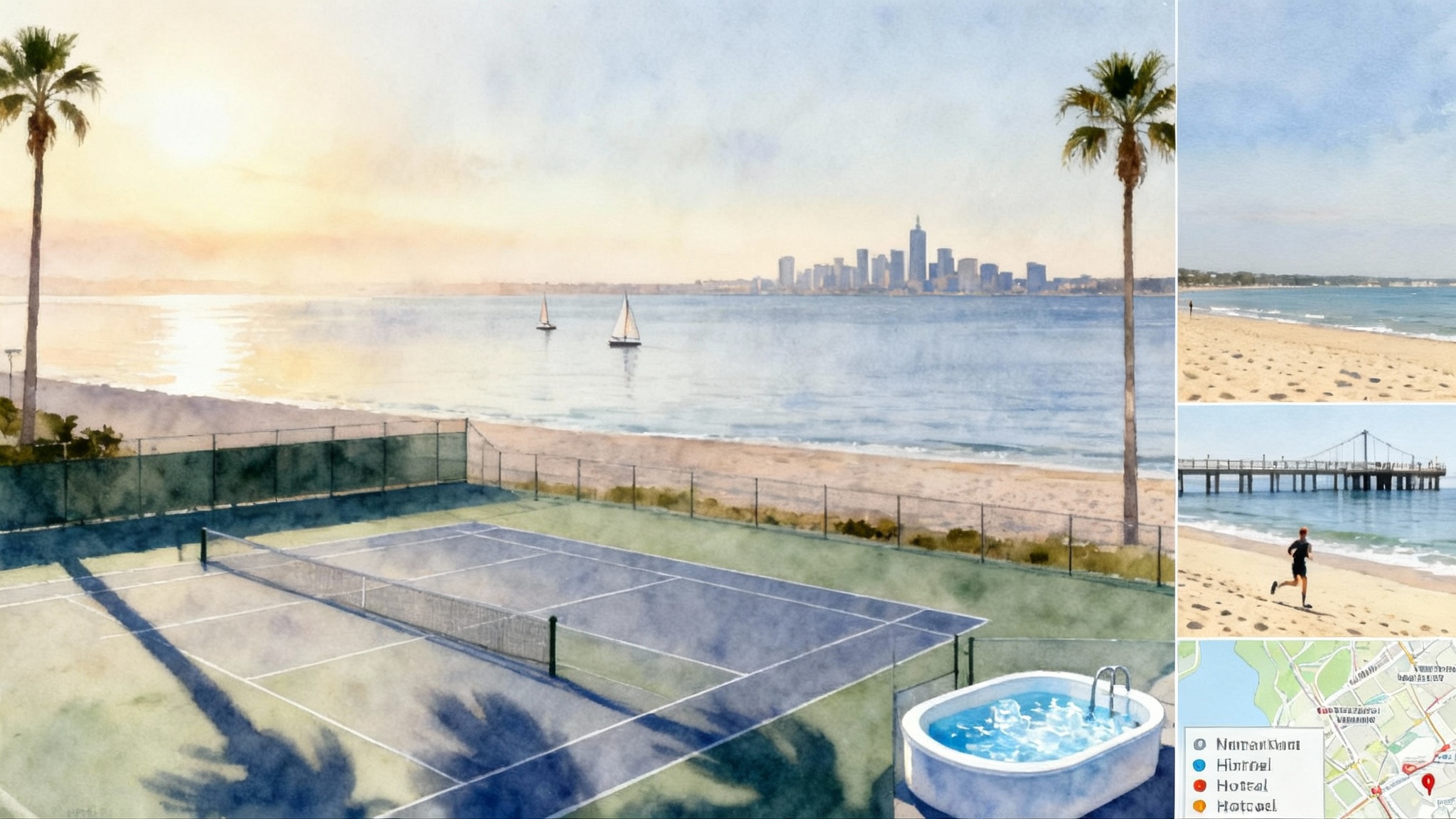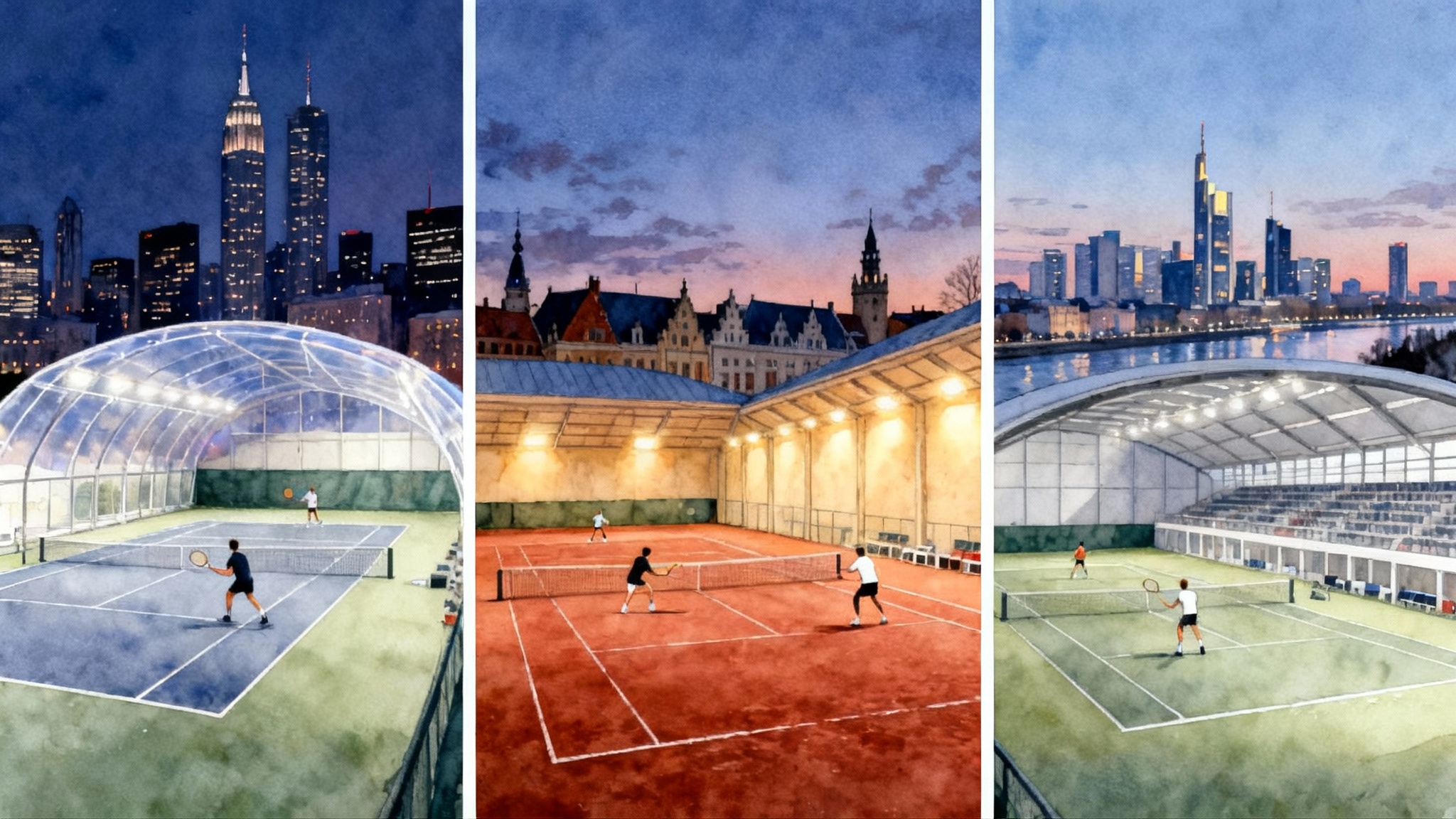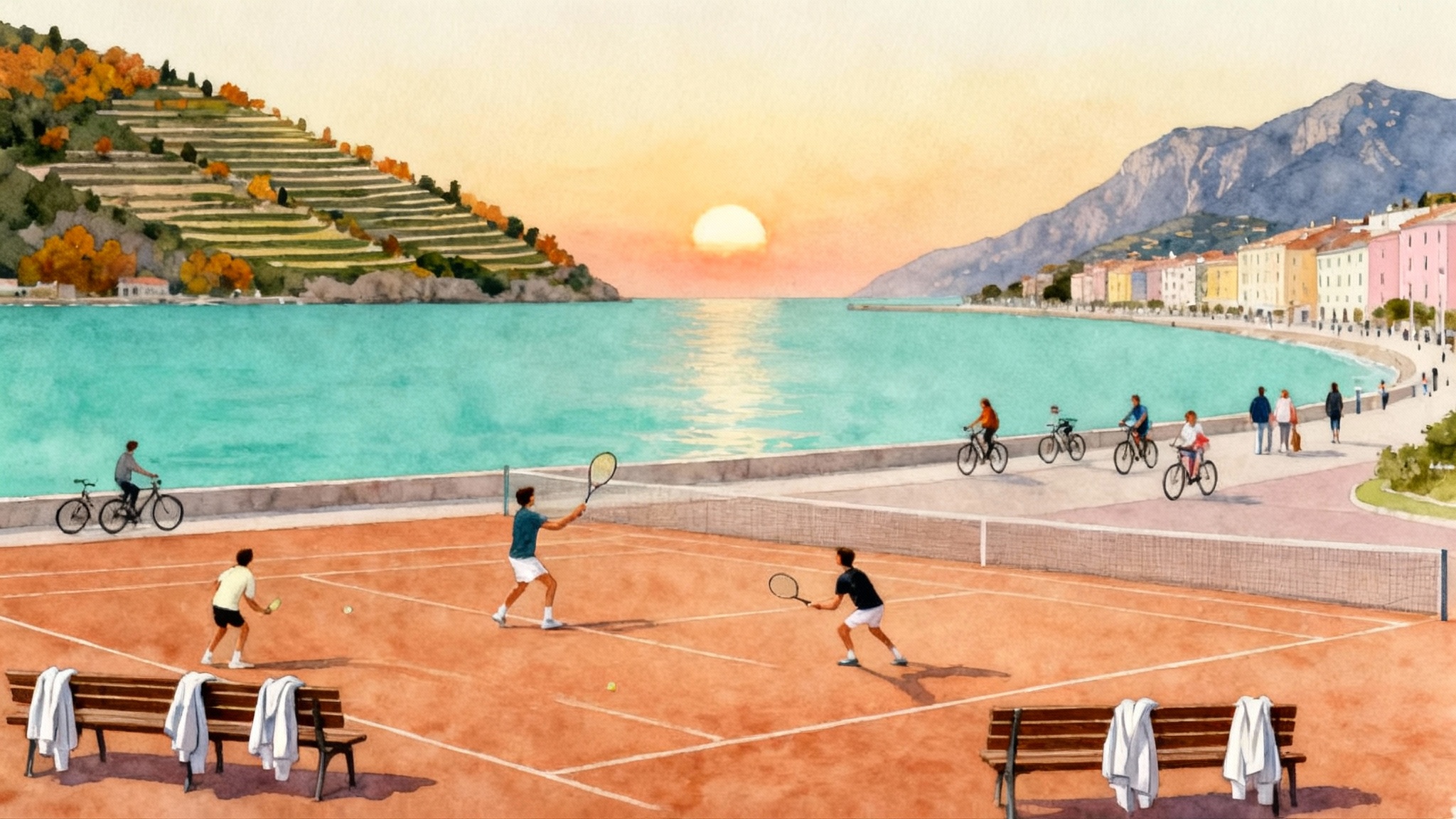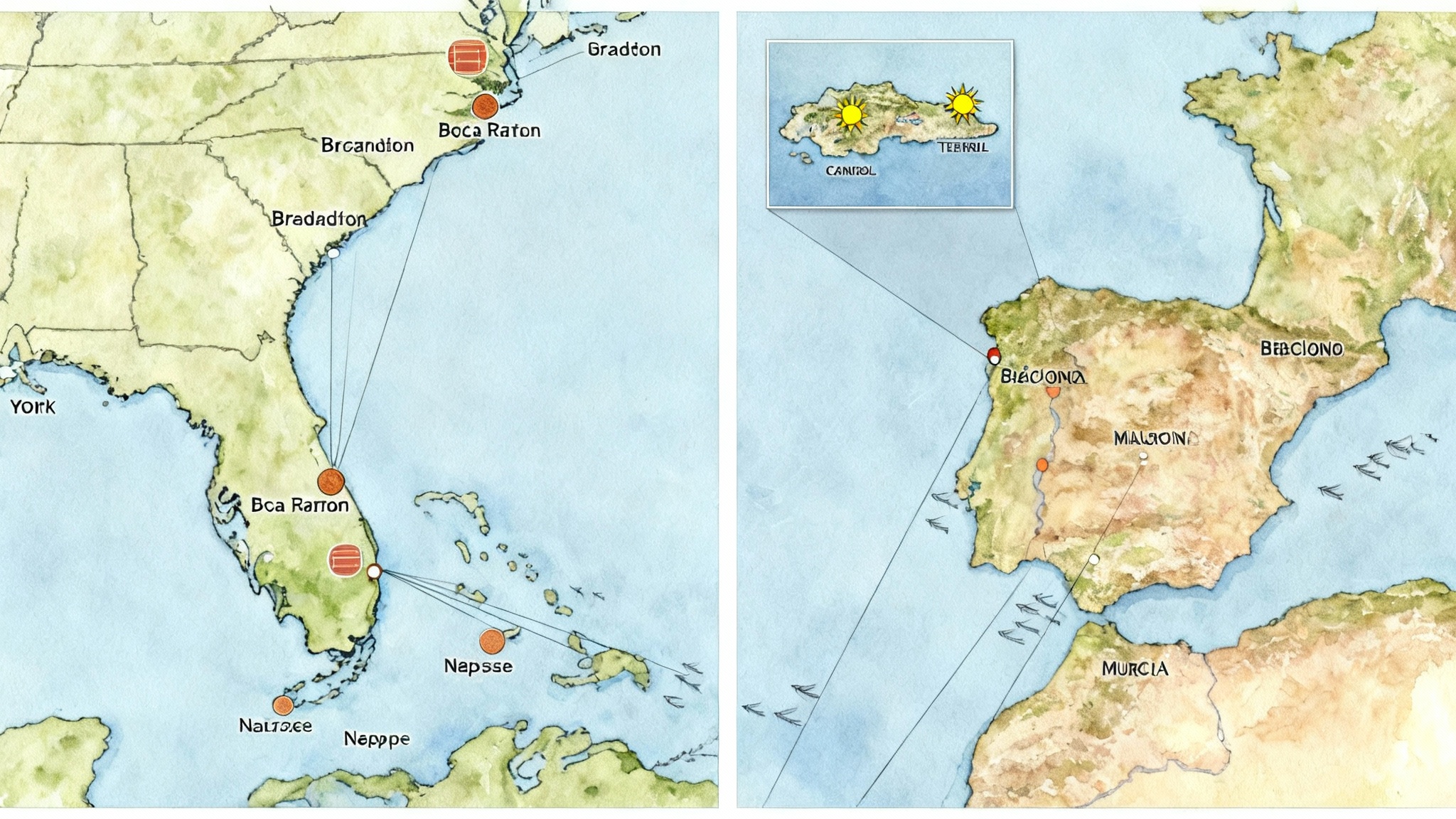Newport Beach: The Ultimate Year-Round Base for Hard-Court Tennis
Plan a serious hard-court block in Newport Beach, California. Mild temps, marine breezes, and a deep tennis scene make October through May and the steady summer ideal. Use Palisades Tennis Club as your daily hub.

Why Newport Beach works for hard-court tennis, twelve months a year
When players talk about weather that helps you train instead of fighting you, they usually mean a place that is cool enough to go hard, dry enough to keep courts playable, and predictable enough for a routine. Newport Beach checks those boxes across every season. Average maximum temperatures run about 62 to 71 Fahrenheit from October to May, with summer peaks around 72 to 73. Annual rainfall is about 11 inches, with most of it in winter. You will rarely lose a full day, and showers often pass quickly. For a data snapshot, see the city’s published average temperature and rainfall table.
Two coastal effects shape your sessions. First is the morning marine layer that keeps the air cool and soft until late morning. Second is the regular afternoon sea breeze that arrives from the west and northwest. That wind is usually steady instead of gusty, which matters for serve rhythm and toss height. On most days you can plan a heavy drill block from 8:00 to 10:30 a.m., lift or recover at midday, then scrimmage from 3:30 to 6:00 p.m. under a gentle breeze and, if needed, lights.
Hard courts here play medium to medium-slow. The combination of sea-level density and cooler air gives you a true bounce, a little more time on the ball, and predictable depth off the backhand corner. If you are coming from heat and altitude, expect your topspin to jump a bit less and your flat serve to feel more controlled. Adjust by dropping string tension one to two pounds and targeting a slightly higher net clearance on heavy rally balls until your depth locks in.
Your daily hub: Palisades Tennis Club
Set your base at Palisades Tennis Club in central Newport Beach, adjacent to the Hyatt Regency Newport Beach and the Back Bay. The club traces its roots to 1974 and has a strong culture of drilling, coached match play, and member-arranged competition. Courts are lighted, and the staff includes experienced pros who can run tough live-ball blocks, feeding sessions, and tactical sparring.
Access is member-focused, but short stays are often possible when you book private lessons or clinics through the coaching staff. The practical play here is to:
- Schedule a morning drill window with a pro who understands your goals. For example, 90 minutes of tempo drilling with specific serve plus one patterns you want to automate.
- Follow with a 30-minute targeted serve basket, then a 20-minute footwork ladder or med-ball sequence on the terrace or gym.
- Return in the late afternoon for coached sparring or arranged matches. Palisades has an established culture of pairing players by level and style, which saves you the energy of fishing for hitters when you should be focusing on quality reps.
If you are a coach traveling with a player, Palisades works well as a daily home base because you can blend your own work with the club’s programming. A typical coach day here looks like two on-court blocks, video capture from the low bleachers on center court, and recovery on site before a short drive to dinner.
What the weather means for your training rhythm
- October to early December: Crisp mornings around the high 50s to low 60s, a few early-season fronts, otherwise dry. Great window for technique consolidation and aerobic base building. Use longer rally count goals and tempo feeding.
- Late December to February: This is the rainier stretch. Plan flexible blocks and have a covered strength or mobility session ready. Showers often clear within hours; if courts are damp, use low-compression or older balls for the first 15 minutes to wick moisture and protect your strings.
- March to May: The most underrated season. Cool mornings, bright afternoons, consistent breezes. Perfect for tactical periodization and match play blocks.
- June to September: Stable and warm without being oppressive. Mornings are premium; heat usually tops out in the low 70s near the water, and evenings are reliable for second sessions.
Practical wind adjustments: warm up your toss with five shadow serves into the breeze, five with the breeze, then alternate. On return practice, start with body serves into the wind to feel the extra sit, then widen targets as you calibrate.
Where to stay within a 10 to 15 minute radius
Choose lodging that keeps your commute short and recovery easy. These picks sit within a quick drive of Palisades and are clustered around the Back Bay, Fashion Island, and the harbor.
- Hyatt Regency Newport Beach: Next door to Palisades with easy walk time. Garden grounds are perfect for morning mobility. Pools and hot tubs help post-match recovery.
- VEA Newport Beach, A Marriott Resort & Spa: At Newport Center. Reliable gym, spa services, and a quiet pool deck for afternoon downtime.
- Renaissance Newport Beach: Near John Wayne Airport. Good choice if you want easy airport access and a modern fitness space.
- Lido House, Autograph Collection: Near the peninsula. Boutique feel, close to beach runs, quick drive in off-peak hours.
- Balboa Bay Resort: On the harbor. Strong spa and water views, useful for true rest days.
- Extended-stay options in the John Wayne Airport corridor: Many have kitchenettes so you can control nutrition, prep electrolyte ice pops, and avoid late dinners out.
If you prefer an apartment, look for short-term rentals in Eastbluff, Corona del Mar, or the Dover Shores area. All three keep you near the club while avoiding weekend tourist traffic on the peninsula.
Recovery that fits the coast
- Beach runs: Warm up from Newport Pier, run south to Balboa Pier on the hard sand near the waterline, and return. That out-and-back is roughly three miles with clean footing and a soft breeze.
- Back Bay loop: The Upper Newport Bay trail system offers packed dirt and paved sections. Use the short hill repeats near the Vista Point pullout for lactate tolerance work without pounding.
- Cold plunge: The Pacific works fine year round. Two to three minutes at the shoreline after a PM session is enough to calm soreness. If you prefer controlled temperature, many hotel spas in the area maintain cool plunge pools; call ahead when you book.
- Physio and bodywork: Costa Mesa and Newport have a deep bench of sports chiropractic and massage providers. Book thirty minutes of soft tissue or a quick dry-needling session on your heaviest match day to preserve range through the week.
- Mobility and breath: Evening sessions on the hotel lawn with light bands, ankle mobility, and five minutes of box breathing help sleep after night matches.
Sample training itineraries
Three-day mini block
-
Day 1
- AM: 30-minute dynamic warmup. Ninety minutes of baseline pattern drilling focused on crosscourt to inside-out forehand. Serve basket with second-serve kick targets. Ten-minute cooldown walk.
- Midday: Protein-forward lunch, feet up for 45 minutes, ten minutes of guided breathwork.
- PM: Coached sparring, two sets. Finish with eight minutes of contrast showers.
-
Day 2
- AM: Return practice. Forty-five minutes of directed return reps against a serving partner. Transition volley and overhead series. Short ad-side tiebreaker.
- Midday: Light mobility and a Back Bay walk.
- PM: Arranged match at the club. Film changeovers for tactical notes.
-
Day 3
- AM: Live-ball games for pace tolerance. Serve plus one depth ladders. Competitive 10-point breaker.
- PM: Optional beach jog and ocean plunge. Early dinner and pack out.
Five-day train and test week
- Day 1: Technical reset. Film forehand and serve for slow-motion review. Afternoon half-court crosscourt games to re-groove spacing.
- Day 2: Load day. Two hard sessions, one feeding-heavy, one live-ball. Add five 200-meter sand strides after the PM hit.
- Day 3: Match play. Morning practice set with coaching interventions at changeovers. Afternoon mobility, calf flush, and short pool session.
- Day 4: Tactical rehearsal. Patterns against a lefty or counterpuncher. Serve targets under mild crosswind. Evening recovery and early sleep.
- Day 5: Test. Enter a local open drill or play a verified USTA practice match. Cold plunge, steak and greens, and a quiet night.
Seven-day shoulder-season camp
- Day 1: Arrival, 60-minute loosen-up hit, grocery run for hydration and breakfast basics.
- Day 2: AM heavy drill block. PM doubles patterns to sharpen returns and first volleys.
- Day 3: AM sparring set plus four-games down scenario work. PM recovery and physio.
- Day 4: Day trip option or a full rest morning with an evening hit under lights.
- Day 5: AM serve plus one depth challenge. PM tournament-style set with a new opponent.
- Day 6: Back-to-back matches if you are prepping for competition; otherwise, live-ball pace day and short sprints on hard sand.
- Day 7: Taper. Forty-five minute rhythm hit, pack, and sunset walk on the peninsula.
Each schedule is built around two truths of Newport Beach tennis: mornings are calm enough for clean technical work, and afternoons bring a steady breeze that teaches you to aim through the court. That progression builds skills that travel.
USTA tournaments you can plug into
Southern California’s calendar is dense, and Orange County venues make it easy to find a draw most weekends. Typical hosts within a short drive include the large municipal complexes in Irvine, Costa Mesa, and Fountain Valley, as well as private clubs that open their gates for sanctioned events. You will find open divisions, National Tennis Rating Program levels from 3.0 through 5.0, and age-group draws.
Use the official Southern California calendar to filter by division, surface, and weekend, then slot your training days around it. Start with the USTA SoCal adult tournament calendar. Enter early; draws at coastal sites fill fast during spring.
Tournament-week tips specific to Newport Beach:
- If a light rain moves through, many hosts will squeeze matches the same day. Keep a dry set of shoes and socks in your car, plus a small towel for grips.
- Expect a mild afternoon crosswind near the coast. Aim to the big half on approach shots and resist overplaying lines.
- Pack a light layer for night matches. Evenings cool quickly after sunset.
Add-ons and day trips
- Indian Wells: The Indian Wells Tennis Garden sits about a two-hour drive inland. If you schedule a day trip, hit early, then grab lunch in Palm Desert to avoid the hottest part of the afternoon. The contrast between desert air and the coast gives you a useful feel for ball speed in different densities.
- Los Angeles clubs and park sites: North and west Los Angeles have a deep network of public and private facilities. Use your coach’s network or the host club’s pro connections to set up a guest hit. If you want a simple ladder-style evening, look for structured doubles socials at reputable park centers in Westwood, Santa Monica, or the South Bay.
- Orange County circuit: On weeks without a tournament, add a match at Lakewood, Seal Beach, or Huntington Beach. Those sites often run leagues and mixers that welcome strong visitors.
For broader planning, compare SoCal’s coastal setup with our Winter 2025 training map and consider a backup U.S. base using this Texas winter tennis guide.
What to pack and how to plan
- Strings and tensions: Bring two reels or four sets per week and adjust tension down one to two pounds on cool, breezy days to maintain depth.
- Footwear: Hard-court shoes with supportive midsoles. Sand runs are great for aerobic work, but do not use your court shoes on wet sand.
- Sun and skin: Even on marine-layer mornings, apply broad-spectrum sunscreen and bring a brimmed hat. Reapply at the second set.
- Hydration: Start the day with 16 to 20 ounces of electrolyte water. During shoulder season you will not feel thirsty until performance dips. Do not wait for that cue.
- Traffic timing: Aim for arrivals before 8:00 a.m. and afternoon returns before 4:00 p.m. or after 6:30 p.m. to keep stress low.
- Film kit: A simple fence mount and phone handle coaching feedback. Palisades court sightlines make it easy to capture both baselines.
Putting it all together
A good week in Newport Beach looks simple on paper: drill in cool, calm mornings; recover and refuel at midday; compete in the breeze; and use the ocean and trails to show up fresh the next day. The mild climate gives you control of your workload, the coastal air keeps rallies honest, and the tennis culture around Palisades fills the opponent gap that ruins many solo training trips. Build your itinerary around those realities and you will leave with patterns that hold up anywhere, not just on a perfect day at the coast.


